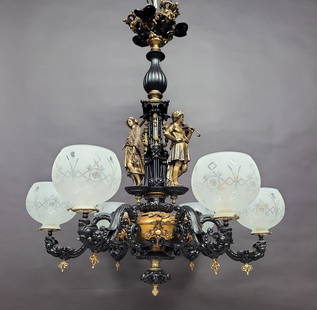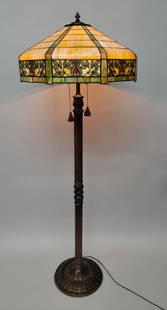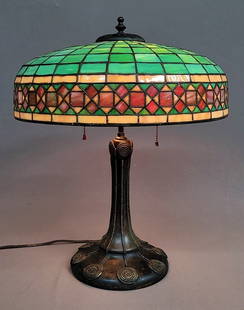
Georg Jensen Sterling Silver Blossom Tray No. 2P
Georg Jensen Sale History
View Price Results for Georg Jensen
Related Tableware & Barware
More Items from Georg Jensen
View MoreRecommended Home & Décor
View More





Item Details
Description
Georg Jensen sterling silver "blossom" oval tray no 2P. Post 1945 design. Measures 7" x 10 3/8". Superb condition. Perfect size for a creamer and sugar (shown in second image but not included) or as a cookie platter or at bedside for a beverage and reading glasses. A similar example can be seen in the book GEORG JENSEN HOLLOWARE, The Silver Fund Collection by David Taylor and Jason Laskey, pg. 41
Dimensions: 7" x 10.38"
Please note that this lot has a reserve. When you leave a bid in advance of the auction, submit your maximum. LiveAuctioneers will bid on your behalf as much as necessary to ensure that you meet the reserve price or that you remain in the lead, up to your maximum. The bidder who has submitted the highest bid wins the lot, provided the bid exceeds the reserve price.
Buyer pays shipping. This item ships from San Francisco, CA
Authenticity is guaranteed. Photos, descriptions and estimates were prepared with the utmost care by a fully certified expert and appraiser.
Your purchase is protected. In the rare event that your purchase from this auction does not meet your expectations, LiveAuctioneers specialists are here to help. If the item did not confirm to the lot description in the sale, U.S. buyers may return the item for a full refund provided you notify LiveAuctioneers within 5 days of receiving your the item. LiveAuctioneers is rated A+ by the Better Business Bureau of New York State.
BIOGRAPHY
Georg Jensen
Georg Jensen grew up in a small village Raadvad, 10 km north of Copenhagen. The close, daily contact with nature in this area turned out to be a continuous artistic inspiration for him through the rest of his life. His superior interpretation of nature and the supernatural world in his ceramics and his works in silver and gold persisted throughout his career.
Georg Jensen started out as an apprentice in the forging department of the knife factory in Raadvad where his father also worked. His family moved to Copenhagen in 1880 and he had to change trades. At this time, he became apprentice to the goldsmith A. R. Andersen 1881-86 in Saint Peders Street 5. Georg Jensen’s teenage dream was to become a sculptor. During his apprenticeship, as well as during his working years 1886-87 as silversmith with goldsmith Holm in Svaertegade, Copenhagen, he improved his abilities in drawing, modeling, and design. During the winter 1886-87 he worked on his first sculpture: a bust of his father. He finished that successfully in April 1887, and it was judged favorably enough to help him gain admission to the School of Sculpture at the Academy of Fine Arts in Copenhagen the same year. The bust was exhibited at Charlottenborg (Copenhagen) in 1889. During his years as a student 1887-92 he received several grants that enabled him to leave his work as silver- and goldsmith, temporarily. During the 1890s he had to return to that work to supplement his income. Even though he had received several grants during these years in appreciation of his talent as sculptor, very few of his sculptures were sold.
In January 1892 he received his diploma from the School of Sculpture at the Academy of Fine Arts. While enrolled at the Academy, he had exhibited several times at the trend making autumn exhibition at Charlottenborg in Copenhagen. He was well accepted by the leaders at the Academy of Fine Arts, such as the Professors Bissen and Stein. He also received good reviews from art critics. In 1893 he was awarded Gold Medal for, “An Archer from Prehistoric Times.” This included a travel grant, which made it possible for him to go on a study-tour to Italy and France during 1894. A small statuette of a goddess, engraved “Copy. Napoli. GJ” on the base, was made on that trip. In the following years he completed several other study tours, in particular to Germany. His longest tour began in 1900, when he was given a large travel-grant from the Academy of Fine Arts in Copenhagen, enabling him to stay abroad for more than a year.
Georg Jensen found most of his inspiration from the nearby natural objects of his everyday life. His sculpting was done of the people who were closest to his heart, among them, his sons Vidar and Jorgen. He was able to transform the shape and feeling of the images into plaster, while at the same time he depicted the beauty without disturbing details. This ability to capture the pure soul of the subject continued when he changed his life to work in silver. This unique ability singled his out as outstanding compared to most of his contemporaries.
By the end of the 1890s Georg Jensen was introduced to Applied Art by Pietro Krohn, who was artistic director at the porcelain factory Bing & Grondahl. Here he learned that design of a high artistic quality could be mass produced. This increase in output could therefore make it a worthy economic venture for Ceramists. He incorporated this philosophy as his own when he began his pottery work. After he decided to concentrate on silver in 1903, he never compromised on a high standard of artistic quality, even though the works were produced industrially.
From The Georg Jensen Society, The Unknown Georg Jensen
The Silversmith
When Jensen was almost forty years old, he faced a major turning point: he decided to become an independent silversmith and give up his long-cherished dream of being a sculptor. He never relinquished the title of sculptor, however, for the rest of his life he listed himself as orfevre sculpteur in the manner of the early goldsmiths of the French court. Later when he could afford it, he had his statue, “The Harvester” cast in bronze. It stands today in the courtyard of the silversmithy in Copenhagen, a reminder of Jensen’s thwarted hopes.
Of great significance in Georg Jensen’s decision to return to silversmithing was his association with the talented artist Mogens Ballin, who created highly original work in metal. While working as a foreman for Ballin, Jensen met the silver designer Johan Rohde. With Ballin, Jensen created his first jewelry, which was bought by the Danish Museum of Decorative Art. This gave him the courage to establish his own workshop. A business man lent him the money to rent a small shop, and on the 19th of April 1904 Jensen opened his first workshop in the courtyard of 36 Bredgade. Each morning he hung on the outside wall of his shop a display case containing his silver work; each evening when he closed the workshop he took it down and carried it back indoors. This was the extent of his public display. In the same year, 1904, he exhibited his jewelry in the Danish Museum of Decorative Art for the first time.
The Jewelry
In his jewelry Georg Jensen created a new style that was not modeled on any style of the past. Made of silver, his jewelry was inexpensive and incorporated amber, malachite, moonstone, and opal - none of which demanded excessive investment. His jewelry was addressed to the open minded middle-class with a sense for the artistic and not to the upper-class for whom jewelry meant first and foremost precious stones in elaborate settings. Closest to Georg Jensen’s work at the time was that of Thorvald Bindesboll. Bindesboll, however, never used stones and his ornamentation was almost completely composed of abstract cloud motifs. In contrast, Georg Jensen never completely gave up the world of flowers and insects that he had known and loved from his childhood days in the woods and meadows around Raadvad.
Holloware and Flatware
So far as the customers’ continued favor is concerned, holloware and flatware have a longer life than jewelry. Good models can be repeated year after year and establish a tradition of taste. One of the silversmithy’s flatware designs from 1915, the Acorn pattern by Johan Rohde, is still the most sold today. Georg Jensen’s first work in holloware was a small teapot with a transverse ivory handle. On the lid a flower is mounted above three leaves. The tense bright surface is rendered lively by hammer marks made while the teapot was shaped and added after the work was formed. The teapot was later supplemented by other pieces to make up a full service, and the design is still of unrivaled quality. The contrast between a living, full-bodied volume and the finely worked ornamentation showed Jensen’s sensitivity to form: he was, after all, a sculptor.
From Renwick Gallery of the National Collection of Fine Arts, Georg Jensen Silversmithy
Please note that this lot has a reserve. When you leave a bid in advance of the auction, submit your maximum. LiveAuctioneers will bid on your behalf as much as necessary to ensure that you meet the reserve price or that you remain in the lead, up to your maximum. The bidder who has submitted the highest bid wins the lot, provided the bid exceeds the reserve price.
Buyer pays shipping. This item ships from San Francisco, CA
Authenticity is guaranteed. Photos, descriptions and estimates were prepared with the utmost care by a fully certified expert and appraiser.
Your purchase is protected. In the rare event that your purchase from this auction does not meet your expectations, LiveAuctioneers specialists are here to help. If the item did not confirm to the lot description in the sale, U.S. buyers may return the item for a full refund provided you notify LiveAuctioneers within 5 days of receiving your the item. LiveAuctioneers is rated A+ by the Better Business Bureau of New York State.
BIOGRAPHY
Georg Jensen
Georg Jensen grew up in a small village Raadvad, 10 km north of Copenhagen. The close, daily contact with nature in this area turned out to be a continuous artistic inspiration for him through the rest of his life. His superior interpretation of nature and the supernatural world in his ceramics and his works in silver and gold persisted throughout his career.
Georg Jensen started out as an apprentice in the forging department of the knife factory in Raadvad where his father also worked. His family moved to Copenhagen in 1880 and he had to change trades. At this time, he became apprentice to the goldsmith A. R. Andersen 1881-86 in Saint Peders Street 5. Georg Jensen’s teenage dream was to become a sculptor. During his apprenticeship, as well as during his working years 1886-87 as silversmith with goldsmith Holm in Svaertegade, Copenhagen, he improved his abilities in drawing, modeling, and design. During the winter 1886-87 he worked on his first sculpture: a bust of his father. He finished that successfully in April 1887, and it was judged favorably enough to help him gain admission to the School of Sculpture at the Academy of Fine Arts in Copenhagen the same year. The bust was exhibited at Charlottenborg (Copenhagen) in 1889. During his years as a student 1887-92 he received several grants that enabled him to leave his work as silver- and goldsmith, temporarily. During the 1890s he had to return to that work to supplement his income. Even though he had received several grants during these years in appreciation of his talent as sculptor, very few of his sculptures were sold.
In January 1892 he received his diploma from the School of Sculpture at the Academy of Fine Arts. While enrolled at the Academy, he had exhibited several times at the trend making autumn exhibition at Charlottenborg in Copenhagen. He was well accepted by the leaders at the Academy of Fine Arts, such as the Professors Bissen and Stein. He also received good reviews from art critics. In 1893 he was awarded Gold Medal for, “An Archer from Prehistoric Times.” This included a travel grant, which made it possible for him to go on a study-tour to Italy and France during 1894. A small statuette of a goddess, engraved “Copy. Napoli. GJ” on the base, was made on that trip. In the following years he completed several other study tours, in particular to Germany. His longest tour began in 1900, when he was given a large travel-grant from the Academy of Fine Arts in Copenhagen, enabling him to stay abroad for more than a year.
Georg Jensen found most of his inspiration from the nearby natural objects of his everyday life. His sculpting was done of the people who were closest to his heart, among them, his sons Vidar and Jorgen. He was able to transform the shape and feeling of the images into plaster, while at the same time he depicted the beauty without disturbing details. This ability to capture the pure soul of the subject continued when he changed his life to work in silver. This unique ability singled his out as outstanding compared to most of his contemporaries.
By the end of the 1890s Georg Jensen was introduced to Applied Art by Pietro Krohn, who was artistic director at the porcelain factory Bing & Grondahl. Here he learned that design of a high artistic quality could be mass produced. This increase in output could therefore make it a worthy economic venture for Ceramists. He incorporated this philosophy as his own when he began his pottery work. After he decided to concentrate on silver in 1903, he never compromised on a high standard of artistic quality, even though the works were produced industrially.
From The Georg Jensen Society, The Unknown Georg Jensen
The Silversmith
When Jensen was almost forty years old, he faced a major turning point: he decided to become an independent silversmith and give up his long-cherished dream of being a sculptor. He never relinquished the title of sculptor, however, for the rest of his life he listed himself as orfevre sculpteur in the manner of the early goldsmiths of the French court. Later when he could afford it, he had his statue, “The Harvester” cast in bronze. It stands today in the courtyard of the silversmithy in Copenhagen, a reminder of Jensen’s thwarted hopes.
Of great significance in Georg Jensen’s decision to return to silversmithing was his association with the talented artist Mogens Ballin, who created highly original work in metal. While working as a foreman for Ballin, Jensen met the silver designer Johan Rohde. With Ballin, Jensen created his first jewelry, which was bought by the Danish Museum of Decorative Art. This gave him the courage to establish his own workshop. A business man lent him the money to rent a small shop, and on the 19th of April 1904 Jensen opened his first workshop in the courtyard of 36 Bredgade. Each morning he hung on the outside wall of his shop a display case containing his silver work; each evening when he closed the workshop he took it down and carried it back indoors. This was the extent of his public display. In the same year, 1904, he exhibited his jewelry in the Danish Museum of Decorative Art for the first time.
The Jewelry
In his jewelry Georg Jensen created a new style that was not modeled on any style of the past. Made of silver, his jewelry was inexpensive and incorporated amber, malachite, moonstone, and opal - none of which demanded excessive investment. His jewelry was addressed to the open minded middle-class with a sense for the artistic and not to the upper-class for whom jewelry meant first and foremost precious stones in elaborate settings. Closest to Georg Jensen’s work at the time was that of Thorvald Bindesboll. Bindesboll, however, never used stones and his ornamentation was almost completely composed of abstract cloud motifs. In contrast, Georg Jensen never completely gave up the world of flowers and insects that he had known and loved from his childhood days in the woods and meadows around Raadvad.
Holloware and Flatware
So far as the customers’ continued favor is concerned, holloware and flatware have a longer life than jewelry. Good models can be repeated year after year and establish a tradition of taste. One of the silversmithy’s flatware designs from 1915, the Acorn pattern by Johan Rohde, is still the most sold today. Georg Jensen’s first work in holloware was a small teapot with a transverse ivory handle. On the lid a flower is mounted above three leaves. The tense bright surface is rendered lively by hammer marks made while the teapot was shaped and added after the work was formed. The teapot was later supplemented by other pieces to make up a full service, and the design is still of unrivaled quality. The contrast between a living, full-bodied volume and the finely worked ornamentation showed Jensen’s sensitivity to form: he was, after all, a sculptor.
From Renwick Gallery of the National Collection of Fine Arts, Georg Jensen Silversmithy
Buyer's Premium
- 10%
Georg Jensen Sterling Silver Blossom Tray No. 2P
Estimate $5,500 - $6,600
3 bidders are watching this item.
Shipping & Pickup Options
Item located in IL, CA, OH, TX, FL, NY, usSee Policy for Shipping
Payment

TOP

















































































